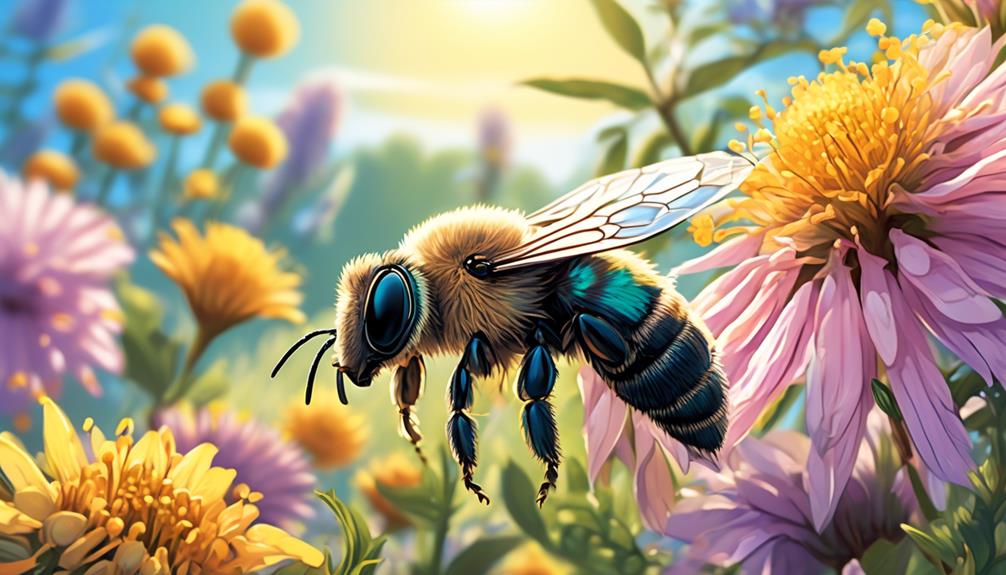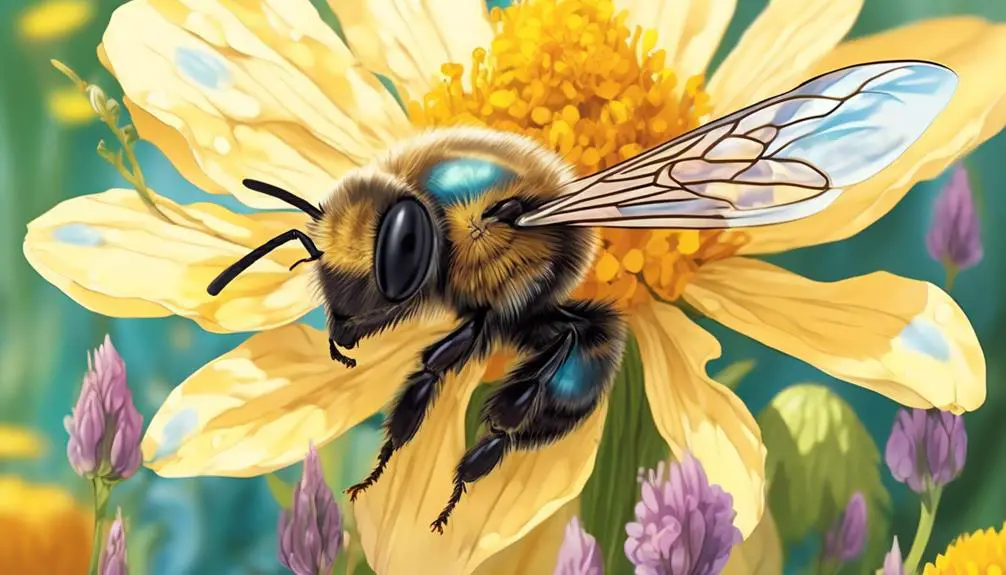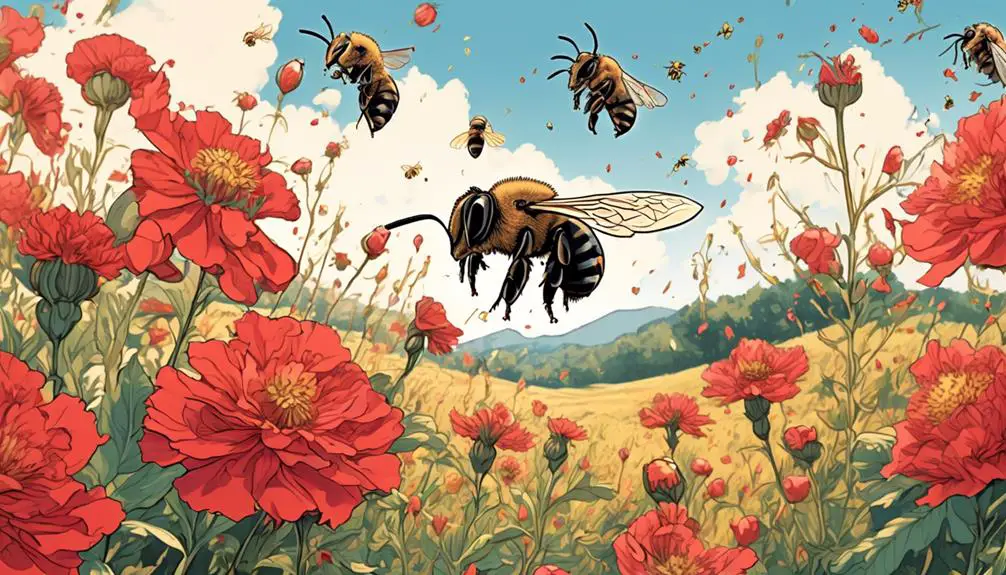Dive into the intriguing exploration of whether Mason Bees are native to Ohio, revealing a new perspective on your local ecosystem.

Are Mason Bees Native to Ohio?
Have you ever pondered the cosmopolitan origins of the humble mason bee? You're not alone in this curiosity. As a resident of Ohio, you've likely observed these industrious creatures buzzing around your backyard, dotting their homes in crevices and holes, diligently working to pollinate our natural world.
But the question remains: are these hardworking insects native to our state, or are they just passing guests? Let's embark on a journey to explore this intriguing question, a quest that might just leave us with a deeper understanding of our local ecosystem.
Key Takeaways
- Mason Bees, specifically Osmia lignaria, are native to Ohio and have been contributing to local biodiversity for a long time.
- They are excellent pollinators and more efficient than honeybees, carrying pollen on their abdomen for more effective transfer.
- Mason Bees play a pivotal role in Ohio's ecosystems by collecting nectar and pollen, fertilizing flowers, and supporting the food chain.
- Supporting Mason Bees through planting native flowers, providing bee-friendly habitats, minimizing pesticide use, and educating others is crucial for their survival and the resilience of Ohio's ecosystems.
Understanding Mason Bees

To fully appreciate the role of Mason Bees in Ohio's ecosystems, it's crucial to grasp their unique biology, reproductive habits, and integral place in pollination networks. You'll find that these bees, unlike honeybees, are solitary creatures. They don't live in hives but in holes in wood or hollow stems, hence their name. Each female is fertile and creates her own nest.
In terms of reproduction, Mason Bees are unique. Females lay both fertilized and unfertilized eggs. The fertilized ones develop into females, while the unfertilized ones become males. Interestingly, they lay female eggs in the back of the nest first and then male eggs. You can think of this as a protective strategy – the males, emerging first in spring, are exposed to predators and weather, while the females stay safe deeper within the nest.
Mason Bees are also incredible pollinators. In fact, they're among the first bees to emerge in the spring, pollinating flowers others might miss. Because they don't have pollen baskets, as they forage, pollen naturally falls off their bodies, leading to more effective cross-pollination. Understanding this, you'll see just how vital these bees are to Ohio's ecosystems.
Mason Bees: Native or Not?

Having explored the unique biology and vital role of Mason Bees in Ohio's ecosystems, let's now address a common question: are these efficient pollinators native to the region or not? The answer is a resounding yes. These bees are indeed native to Ohio, and they've been contributing to local biodiversity for a long time.
Scientifically known as Osmia lignaria, Mason Bees are a part of the Megachilidae family, which is widespread across North America, including Ohio. They've been witnessed in the region for many years, indicating their native status. Their presence is beneficial as they're known to be excellent pollinators, often more efficient than honeybees.
However, it's necessary to distinguish between native and non-native species within the Mason Bees. While Osmia lignaria is native, the introduced species like Osmia cornifrons, commonly known as the horn-faced bee, is not. This species was intentionally introduced from Japan for agricultural pollination in the early 1990s.
The Role of Mason Bees in Ohio

In light of their native status, Mason Bees play a pivotal role in Ohio's ecosystems, largely due to their superior pollination capabilities. You'll find these industrious creatures buzzing around the state from early spring to late fall, diligently collecting nectar and pollen. But they're not just after a meal. As they move from flower to flower, they inadvertently carry pollen on their bodies, effectively fertilizing flowers and enabling the production of fruits and seeds.
Unlike honeybees, which collect pollen on their hind legs, Mason Bees carry pollen on their abdomen. This location allows for more efficient pollen transfer, resulting in a higher fertilization rate. In fact, it's estimated that a single Mason Bee can do the work of up to 100 honeybees!
Moreover, Mason Bees don't just pollinate any plant they come across. They've adapted to favor native flora, meaning they play a critical part in preserving Ohio's biodiversity. By pollinating native plants, they help maintain the balance of local ecosystems and support other wildlife species.
Mason Bees: Impact on Ecosystem

Building on their role as efficient pollinators, Mason Bees' impact on the ecosystem extends even further, proving their integral part in the environmental harmony of Ohio. As you delve into the web of interactions, you'll find that Mason Bees, like most pollinators, play a crucial role in maintaining biodiversity. Pollination contributes to the survival and reproduction of plants, which in turn provides food and habitat for a variety of wildlife.
You mightn't realize it, but Mason Bees' pollination capabilities create a ripple effect. When they pollinate a flower, it leads to the production of fruits and seeds. These fruits and seeds are then consumed by other creatures, effectively supporting the food chain. Moreover, Mason Bees' preference for native plants helps restore and propagate these species, enhancing Ohio's natural landscapes and ecosystems.
Their presence also offers a barometer for ecological health. A decline in Mason Bees often indicates environmental stressors such as habitat loss or pesticide exposure. Consequently, their conservation becomes paramount, not only for their survival but also for the overall resilience of Ohio's ecosystems. They're not just bees; they're environmental superheroes, actively contributing to the balance of nature.
Supporting Ohio's Mason Bees

Ohio's Mason Bees need your support to maintain their crucial role in the ecosystem, and fortunately, there are numerous steps you can take to help these environmental superheroes thrive. Planting native Ohio flowers, providing bee-friendly habitats, and minimizing pesticide use are just a few ways you can contribute to their survival.
Action | Impact on Mason Bees |
|---|---|
Plant native flowers | Provides pollen and nectar, essential for bee survival |
Provide habitats | Offers safe spaces for bees to nest and reproduce |
Minimize pesticide use | Reduces threats to bee health and longevity |
Educate others | Increases community-wide support for bee conservation |
Support local beekeepers | Encourages sustainable beekeeping practices |
Each action you take, no matter how small, can have a significant impact on Ohio's Mason Bees' population. By educating others about these incredible creatures' importance, you can foster a community-wide effort to support them. Remember, every flower planted, every pesticide-free garden, and every supportive conversation can help these bees continue their essential work in our ecosystem.
Conclusion
Yes, Mason bees are indeed native to Ohio.
Their role in the ecosystem, particularly in pollination, is crucial.
Their presence impacts the health and diversity of Ohio's flora, contributing to a balanced environment.
As Ohioans, it's our responsibility to support these industrious creatures, whether it's through creating bee-friendly habitats or advocating for their protection.
Understanding their native status and ecological impact helps us recognize their indispensable role in our environment.



